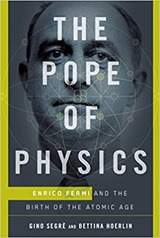 The Pope of Physics by Gino Segrè and Bettina Hoerlin is the biography of Enrico Fermi. I haven’t read any scientific biography for a while and this book on Enrico Fermi was on my list. He is perhaps best known for leading the team that constructed the first artificial nuclear reactor as part of the Manhattan Project. As a lapsed chemical physicist I also know him for Fermi surfaces, Fermi-Dirac statistics, and the Fermi method. Looking on Wikipedia there is a whole page of physics related items named for him.
The Pope of Physics by Gino Segrè and Bettina Hoerlin is the biography of Enrico Fermi. I haven’t read any scientific biography for a while and this book on Enrico Fermi was on my list. He is perhaps best known for leading the team that constructed the first artificial nuclear reactor as part of the Manhattan Project. As a lapsed chemical physicist I also know him for Fermi surfaces, Fermi-Dirac statistics, and the Fermi method. Looking on Wikipedia there is a whole page of physics related items named for him.
Fermi was born at the beginning of the 20th century, his parents were born before Italy was unified in 1870 when illiteracy was not uncommon and people typically stayed close to home since travel quickly involved crossing borders.
Fermi was identified as something of a prodigy whom a friend of his father, Adolfo Amidei, took under his wing and smoothed his path to Pisa Scuola Normale Superior. As I sit here in in a mild lockdown I was bemused to note that the entrance exams Fermi took were delayed by the 1918 Spanish Flu pandemic. At Pisa Fermi learned largely under his own steam, at the time physics was not an important subject – the Pisa Scuola had five professors in physics and only one in physics. Fermi graduated at the top of his class.
After Pisa Fermi fell into the path of Orso Mario Corbino, a physicist, politician and talented organiser who set about helping Fermi to build a career in physics. At the time a new quantum physics was growing, led primarily by young men such as Pauli, Dirac, Heisenberg and Schrödinger who was a little older. Fermi met them on a scholarship to Göttingen in Germany. He later went to Leiden on a scholarship where he met Ehrenfest, and Einstein who was very taken with him. This was preparation for building a new physics capability in Italy.
The fruits of this preparation were a period in the mid-1930s which saw Fermi and his research group at Rome University invent a theory of nuclear decay which revealed the weak nuclear force and postulated the existence of the neutrino (this theoretical work was Fermi’s alone). The wider research group studied the transmutation of elements by slow neutron bombardment. This work was to win Fermi the 1938 Nobel Prize for Physics.
This research led on directly to the discovery of nuclear fission and the chain reaction which became highly relevant as Fermi fled Italy to the US with his wife on the eve of the Second World War. Many of Fermi’s friends, including his wife Laura, were Jewish. Fermi steered clear of politics to a large degree, he benefitted from the patronage of Mussolini but was no fascist enthusiast. The Italian uses of chemical weapons in Ethopia and, ultimately, the racial laws of the late 1930s which expelled Jews from their positions drove him from the country. He had visited the US a number of times in the early 1930s and had little trouble finding a position at Columbia University.
The route to the atomic bomb was not quick and smooth in the early years of the war, a number of physicists had noted the possibility of the fission bomb and attempted to warn politicians of its potential. This all changed when the Americans joined the war, following the Japanese attack on Pearl Harbour.
Building an atomic bomb presented a number of scientific challenges which Fermi was well-placed to address, primary amongst these was building “Critical Pile 1” the first system to undergo a self-sustaining nuclear chain reaction. It was constructed, slightly surreptitiously, in a squash court at Chicago University. It was built there as a result of a dispute with the contractor who was due to build it a little outside Chicago, at Argonne.
The “critical pile” demonstrated two things: firstly that chain reactions existed, and secondly it provided a route to producing the nuclear isotopes required to produce a bomb. It still left the question of how to purify the isotopes, and the question of how to produce a critical mass fast enough to cause a worthwhile explosion.
Fermi would go on to help in the Manhattan Project at Hanford and then Los Alamos where he held a position combining both universal scientific consultancy and administration, or at least organisation.
It is difficult to talk about Fermi’s strengths as a physicist – he had so many – he is almost unique in being both a top flight experimentalist, and theoretician. This is the great divide in physics, and people who are talented in both fields are rare. He was also clearly an excellent teacher, as well as undergraduate teaching and writing a high school physics book he supervised 7 students who would go on to earn Nobel Prizes in physics. Alongside this he was clearly personable.
Fermi died in November 1954 a little after his 53rd birthday, leaving in his wake a large number of prizes, buildings and discoveries as a memorial.
I found The Pope of Physics highly readable, the chapters are quite short but focused.

